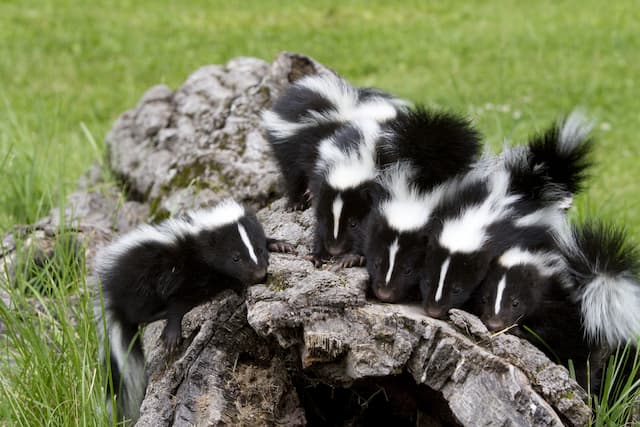The advent of spring in the enchanting world of urban wildlife brings with it new life and the pitter-patter of tiny paws. Skunks, with their distinctive markings and reputation for possessing foul-smelling defences, are not an exception. However, when skunk families move into human habitats, managing their eradication becomes a delicate endeavour requiring a considerate and humane approach.
Care for Mothers and Baby Skunks
Skunks are attentive mothers who provide devoted care for their young. Typically, skunk mating season takes place in late winter, and females give birth to their young in dens in the spring. Born blind and defenceless, these kits rely solely on their mother for food, warmth, and protection. As they mature, they leave the den under her watchful eye in order to investigate and acquire vital survival skills.
The Ethical Implications
When a skunk family with young is encountered, ethical considerations become paramount. Prematurely separating mother skunks from their young can be detrimental to both parties. The emotional distress caused by separation can negatively impact the mother skunk’s health, while the defenceless pups may be unable to survive on their own.
A Humane Methodology for Professionalism
The elimination of skunks with young requires the expertise of specialists who comprehend the complex dynamics of skunk families. Humane skunk removal professionals take a comprehensive approach that considers the well-being of all parties involved. By waiting until the kits are ambulatory and self-sufficient, these specialists ensure that the removal occurs at a time when the kits have a greater chance of survival.
Strategies for Elimination
The eradication of skunks with infants requires meticulous planning and execution. Professionals evaluate the den site, the number of pups present, and the mother skunk’s behaviour. Once the time for removal has been determined, exclusion techniques are utilized to coax the skunk family to relocate. These techniques ensure a safe and stress-free transition for both the mother and her young.
Bringing Mother and Kits Together
In situations considered safe and feasible, it is possible to reunite mother skunks with their young after removal. This strategy entails temporarily housing the young while the mother is relocated in safety. After successfully relocating the mother skunk, the kits are carefully introduced to the new den site, allowing for a heartwarming reunion that preserves the family connection.
A Harmonious Coexistence
Managing skunk removal with infants demonstrates the significance of humane coexistence with wildlife. By recognizing the complex family dynamics of skunks and prioritizing their welfare, we recognize the contribution these animals make to the urban ecosystem. Beyond the individual animal, the delicate balance of life and survival encompasses the web of interdependent relationships that sustains our shared environment.
Education and Awareness-Raising
Essential for fostering a culture of responsible coexistence is raising awareness about skunk families and the significance of humane removal techniques. Educating the community about the natural behaviours of skunks and the potential consequences of premature separation promotes understanding and empathy.
A Proclamation of Stewardship
Managing skunk removal with infants is a demonstration of our environmental stewardship. It demonstrates our dedication to preserving the intricate tapestry of urban life. By adopting a humane strategy that respects the familial bonds of skunks, we contribute to the harmonious coexistence of all inhabitants, from the tiniest pups to the humans who share their world.
Contact us for more information about our humane Skunk Removal Oshawa services.Call us today on 647-694-3620 to book an appointment.
